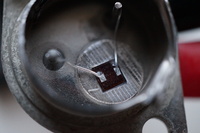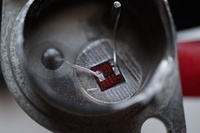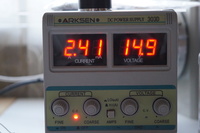Transistor as a light source
Tags:In this note I demonstrate that a bipolar transistor can be made to emit light.
Demonstration
For observing this effect, it’s best to use a big, easy to decap transistor with massive body that would function as a heatsink. КТ805БМ in TO-3 package (known in the West as BDW21A) is perfectly fit for the task.
First, we need to decap it. This is somewhat problematic, as TO-3 features a solid 1mm of aluminium. I broke a diamond disc and two endmills while trying to decap it by hand and using my CNC mill, and eventually pried the half-detached cap out using diagonal cutters. It was not an enjoyable process, but it worked.
Then, it is necessary to apply reverse voltage across the base-emitter junction. The junction starts (reversibly) break down at about 10.9V. The die will start to emit a significant amount of light (as well as heat like crazy) at 2A and higher.
Explanation
The breakdown of the p-n transition happens due to the avalanche effect. The recombination of the holes and electrons necessarily converts excess energy into some other form; in this case, photons are emitted.
The transistor is not damaged, unless allowed to overheat.




